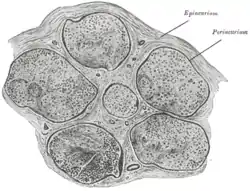Perineurium
The perineurium is a protective sheath that surrounds a nerve fascicle.[1] This bundles together axons targeting the same anatomical location.[1] The perineurium is composed from fibroblasts.[2]
| Perineurium | |
|---|---|
 Transverse section of human tibial nerve (perineurium labeled at upper right) | |
 Nerve structure | |
| Identifiers | |
| TA98 | A14.2.00.015 |
| TA2 | 6156 |
| FMA | 52585 |
| Anatomical terminology | |
In the peripheral nervous system, the myelin sheath of each axon in a nerve is wrapped in a delicate protective sheath known as the endoneurium. Fascicles, bundles of neurons, are surrounded by the perineurium. Several fascicles may be in turn bundled together with a blood supply and fatty tissue within yet another sheath, the epineurium. This grouping structure is analogous to the muscular organization system of epimysium, perimysium and endomysium.
Structure
The perineurium is composed of connective tissue, which has a distinctly lamellar arrangement consisting of one to several concentric layers. The perineurium is composed of perineurial cells, which are epithelioid myofibroblasts. Perineurial cells are sometimes referred to as myoepithelioid due to their epithelioid and myofibroblastoid properties including tight junctions, gap junctions, external laminae and contractility. The tight junctions provide selective barrier to chemical substances.
The perineurium is a smooth, transparent tubular membrane which may be easily separated from the fibers it encloses. In contrast, the epineurium is a tough and mechanically resistant tissue which is not easily penetrated by a needle.
References
- McCracken, Thomas (1999). New Atlas of Human Anatomy. China: Metro Books. pp. 96–97. ISBN 1-5866-3097-0.
- Weerasuriya, ANANDA (2005-01-01), Dyck, Peter J.; Thomas, P. K. (eds.), "Chapter 29 - Blood-Nerve Interface and Endoneurial Homeostasis", Peripheral Neuropathy (Fourth Edition), Philadelphia: W.B. Saunders, pp. 651–665, doi:10.1016/b978-0-7216-9491-7.50032-6, ISBN 978-0-7216-9491-7, retrieved 2020-11-18
External links
- Histology image: 1_03 at the University of Oklahoma Health Sciences Center - "Peripheral nerve"
- Anatomy photo: nervous/pns/nerve1/nerve2 - Comparative Organology at University of California, Davis - "PNS, nerve (LM, Low)"
- Histology image: 21401loa – Histology Learning System at Boston University
- Diagram at Howard
- Histology at ucla.edu